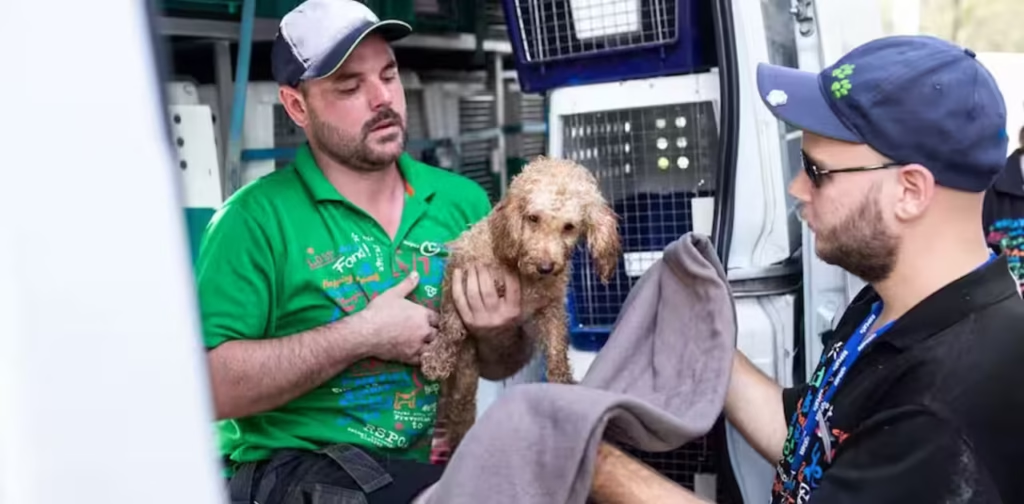Why are animal rescues so important? very much?
Each year hundreds of thousands of dogs are left or neglected.
For every heartbreaking tale animals are rescued by organizations helping turn the situation around.
This article delves into the realm of rescue groups’ news, their heroes and difficulties, and the ways they’re creating an impact.
Let’s look at how these organizations are dealing with a crisis and offering animals another chance.
What Are Animal Rescue Groups?
The animal rescue organizations are not-for-profit groups or initiatives that are run by volunteers.
They are focused on saving pets in distress, rehabilitation them, and finding happy homes.
Here’s what they do typically:
- Help animals abandoned from streets, shelters, or other dangerous environments.
- Offer medical treatment as well as vaccinations and spaying/neutering treatments.
- Rehabilitation of animals who have suffered the trauma of neglect or abuse.
- Educate communities about responsible pet ownership.
- Allow adoptions to ensure that animals get the ideal forever homes.
Types of Animal Rescue Groups
Not all rescue organizations are created equal.
Some are focused on specific species, whereas others are interested in considering all animals, big and small.
- Cat and dog rescue: The most common rescue of domestic pets from streets and shelters.
- Wildlife rehabilitation: Aiding wounded or dislocated wild animals like deer, birds, or squirrels.
- Animal rescues from farms: Rescuing cows, chickens, and pigs from factories or from neglect.
- Rescues for specific breeds Optimized to help specific breeds like Labrador Retrievers or Siamese cats.
- Pet rescue operations that are exotic: Caring for reptiles exotic birds, reptiles, and other pets that are unusual and cannot handle.
Current Trends in Animal Rescue Group News

The animal rescue community is constantly buzzing with stories.
Here are a few of the hottest fashions:
1. Increased Awareness of Adoption
Adoption is becoming more popular instead of buying pets.
Campaigns such as “Adopt, Don’t Shop” have gained popularity and have prompted people to donate to rescues.
2. Natural Disasters Leading to Rescue Surges
From wildfires to hurricanes, natural disasters can leave animals in a strand.
Animal rescue groups take on the task of offering temporary shelters as well as returning pets to their owners.
3. Use of Technology in Rescues
Apps websites, apps, and social media have made it easier for rescue organizations to connect pets with adopters.
Platforms for pet adoption and fundraising campaigns on the internet have changed the game.
4. Community Support Through Volunteering
A growing number of people are joining forces to foster animals, provide equipment, or aid in rescue efforts.
Why Are Animal Rescue Groups So Important?
The fact is that more than 6.5 million animals are rescued each year across the US all by themselves.
If there weren’t rescue organizations, a lot of these animals would die.
This is why their work is important:
- Reduces the rate of euthanasia in shelters that are overcrowded.
- It gives animals another chance to live.
- Enhances community by controlling animals.
- informs the general public on responsible ownership of animals and the welfare of their owners.
Examples: A rescue group in Texas helped save more than 200 dogs from a situation of hoarding by rehabilitating them and giving them homes that are loving.
Challenges Facing Animal Rescue Groups
There’s more to it than rainbows and sunshine for rescue groups.
They have to overcome significant obstacles each and every day:
1. Funding Shortages
The majority of rescues rely on grants and donations for their operations.
In the absence of constant funding, it can be difficult to pay for food, vet bills, and shelter costs.
2. Overcrowding
The demand can be higher than capacity.
Rescue groups are constantly searching for foster homes in order to lessen the stress.
3. Emotional Toll
Rescuers often witness heartbreaking stories of neglect and abuse.
The emotional strain can cause burnout.
4. Lack of Public Awareness
A lot of people choose to purchase pets instead of adopting, thus perpetuating the cycle of abandonment.
How Can You Support Animal Rescue Groups?
Are you looking to make an impact?
This is how you could be of assistance:
1. Adopt, Don’t Shop
You might consider adopting your pet by rescuing it instead of purchasing one through a breeder.
2. Donate Money or Supplies
Every penny is important.
The funds help pay for medical treatment as well as food and bedding to help keep rescuers going.
3. Volunteer Your Time
- Dogs on walks.
- Foster animals.
- Assist with the organization of events.
There’s always something interesting to do.
4. Spread the Word
Post stories of rescue via social networks.
The more people are aware that they are a part of it, the more help these groups receive.
5. Advocate for Animal Welfare
Advocate for legislation that protects animals and promotes rescue initiatives.
Inspiring Stories From Animal Rescue Group News

Let’s take a look at some actual examples:
1. Hurricane Harvey Rescues
Following the devastating hurricane of 2017 rescue groups rescued hundreds of pets.
Teams worked tirelessly to build temporary shelters and help rehome pets that had been abandoned.
2. From Puppy Mill to Pampered Life
A puppy mill located in the Midwest was shut down and more than 150 dogs were saved.
One pet, Bella, went from an uninviting cage to a home that was loving and with family.
3. Senior Dog Adoption Movement
Rescue groups are focused on senior pets.
The elderly animals are often left out however campaigns have been able to locate them homes so they can live to their final years.
FAQs About Animal Rescue Groups
1. Where can I find a local rescue organization?
Check out online search engines or platforms such as Petfinder or Adopt-a-Pet.
Many rescue organizations also are active on social media accounts.
2. Are all rescue groups nonprofit?
Many are, but a few have different methods of operation.
Always do your research prior to making a donation or adopting.
3. If I want to be adopted, can reside in an apartment?
Yes!
Rescues will assist you in matching you with a pet that is appropriate for your lifestyle.
4. What should I contribute to a rescue organization?
- Money
- Pet food
- Blankets
- Cleaning products
- Toys
5. Is fostering difficult?
It’s not easy yet it’s extremely rewarding.
You’re providing an animal with an opportunity to recover and flourish.
The Bottom Line
Animal Rescue groups do amazing work each day.
They’re helping save lives, bringing awareness, and creating healthier futures for both humans and animals alike.
It doesn’t cost any time at all.
If you decide to donate, volunteer, or adopt, each step you take can make an impact.
Let’s join in the solution and continue to keep the spotlight on rescue animal group information.
Innovative Approaches in Animal Rescue
The field that rescues animals is changing and innovative ideas transform the way animal rescue is done. Here are some revolutionary techniques that are making waves:
1. TNR (Trap-Neuter-Return) for Stray Cats
The number of cats in the Stray Cat population can explode out of control.
TNR programs are focused on capturing, sterilizing, and reintroducing cats back to their natural surroundings.
This method helps to reduce overpopulation without causing harm to the animals.
2. Virtual Adoptions
Thanks to online tools, people can now adopt pets from various states or even nations.
Rescue groups coordinate transport, making it more convenient for animals to locate homes outside their immediate vicinity.
3. Therapy Animal Partnerships
Certain rescues train their animals to serve as therapy animals for schools, hospitals, or even care homes.
Animals serve a purpose and assist people in healing emotionally.
Example:
A dog rescued by Max was turned into an animal therapy pet for vets suffering from PTSD showing how pets that are rescued can make a difference in people’s lives.
Misconceptions About Animal Rescue Groups

Let’s look at some of the most common myths:
1. “Rescue Animals Are Broken”
Many believe that pets who are rescued may have health or behavioral problems.
The truth? Many are perfectly well-nourished and eager to be loved.
2. “You Can Only Find Mutts at Rescues”
Although mixed breeds are not uncommon, however, breed-specific rescues are available.
You can take a purebred puppy without assisting breeders who are not ethical.
3. “Adoption Processes Are Too Strict”
Yes, rescue vets adopters cautiously, but this is for the animal’s safety.
They want to create matches that will last for a lifetime.
4. “Older Pets Don\u2019t Bond Like Puppies”
Older pets tend to adapt faster and require less care.
They’re loving companions and waiting to ease into your routine.
The Role of Social Media in Animal Rescue Group News
Social media has transformed the way rescue organizations work. Here\u2019s how:
1. Highlighting Success Stories
Platforms such as Instagram and TikTok show transformations before and after.
These stories encourage people to take on the role of adopting or making donations.
2. Crowdfunding for Emergencies
When a rescue has to deal with an unexpected crisis, such as a huge medical bill, social media can help raise funds quickly.
3. Finding Lost Pets
The Lost and Found groups On Facebook and other platforms help to connect countless animals with their owners.
Building a Rescue-Friendly Community
If you’re looking to go beyond the individual effort Here’s how you can improve the rescue-friendly community you live in:
1. Host Fundraisers
Create baking sales fun runs or online events to aid local rescue organizations.
2. Educate Neighbours
Provide workshops on spaying/neutering and responsible pet care.
3. Set Up Food Donation Stations
Gather pet food and other items to give to shelters in need.
Future of Animal Rescue Groups
What’s next for the world in the field of rescuing animals?
1. AI and Data Tracking
Rescue organizations are now using AI to monitor stray groups to identify trends, forecast them, and more efficiently allocate resources.
2. Mobile Rescue Units
The availability of mobile clinics and rescue vehicles aids in reaching remote or devastated areas.
3. Corporate Partnerships
Brands from the top are partnering with rescue organizations to help fund operations, boost adoption,n and raise awareness.
Example:
A major pet food company recently sponsored spay/neuter clinics for free which helped a multitude of animals.
Final Thoughts on Animal Rescue Group News
Animal rescue organizations are the unspoken heroes of our communities.
Every day, they face problems, saving lives and bringing hope to animals and human beings alike.
The positive news?
It doesn’t matter if you are on the frontline to have an impact.
Volunteer, adopt, donate or just help spread the word.
Even the smallest of actions can be a ripple into something much larger.
Let’s keep the conversation alive and continue to support these incredible organizations.
The news from the Animal Rescue Group isn’t only about animals, it’s about creating a better world for us all.
Read More: digiwebgrowth


